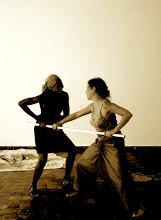quinta-feira, 19 de novembro de 2009
Performance no Braço de Prata, nov.2009
A BRIDGE TO A TIMELESS PLACE
"Life lived with poetry in mind is itself an Art"
Ferlinghetti
quarta-feira, 18 de novembro de 2009
ensaio de 'A Bridge to a Timeless Place', 2009
Ferlinghetti
terça-feira, 6 de outubro de 2009
"A Bridge to a Timeless Place- performance for two living beings" (coming soon on Braço de Prata...)
 "Two women" by Sofia Ferreira 2006
"Two women" by Sofia Ferreira 2006After the journey there is...staying, remaining and relating. This 'relating' is what interests us most, because it contains in itself a constant possibility of discovery and rewriting of the Present.
"Every movement means occupation and definition of a
new border and transformation will occur on both sides!"
It carries also a responsability towards the knowledge of the past, although it brings in itself the seed of the new each moment!
"...even in Raissa, sad city, runs an invisible thread that bonds a human being to another for a moment, and then tears itself apart before streching itself between moving points, drawing new quick sketches, in such a way that in every second the unhappy city contains a happy city that isnt even aware that she exists."
Italo Calvino (The Invisible Cities)
They are together and they relate through a rope or a feeling of intimacy. The rope allows the exploration of physical situations as a contrast between imobility and expansion, contention and movement. They can create one, two or as many forms as they wish... to experience a poetic metamorphosis of that volatile territory, with no time and no place, that Human Relations are.
"Poetry, the shortest distance between two human beings"
Ferlinghetti (Poetry as Insurgent Art)
Depois da viagem existe ... o ficar, o permanecer e o relacionar.
Este 'relacionar' é o que nos interessa mais, pois contém em si a constante possibilidade de descoberta e reformulação do Presente.
"Cada movimento significa ocupação e definição de uma
nova fronteira e a transformação ocorre em ambos os lados"
Acarreta também uma responsabilidade em relação ao conhecimento do passado, mas traz em si também a semente do novo a cada instante!
''... mesmo em Raissa, cidade triste, corre um fio invisivel que liga um ser vivo a outro por um instante,
e a seguir se desfaz, e depois torna a estender-se entre pontos em movimento,
desenhando novas rápidas figuras, de modo que a cada segundo a cidade infeliz
contêm uma cidade feliz que nem sequer sabe que existe.''
Italo Calvino (As Cidades Invisiveis)
Elas estão juntas e relacionam-se através de uma corda ou um sentimento de intimidade.
A corda permite a exploração de situações fisicas, contrapondo imobilidade e expansão, contenção e movimento. Poderão gerar uma forma, duas formas, ou muitas formas... para experienciar a metamorfose poética desse território volátil, sem tempo nem lugar, que é o das Relações Humanas.
"Poesia, a menor distancia entre dois seres humanos."
Ferlinghetti (Poesia como uma Arte Insurgente)
segunda-feira, 14 de setembro de 2009
segunda-feira, 7 de setembro de 2009
"Rosário-Ecce Virgo Concipiet" Already on a street near you

pulchra ut luna, electra ut sol, terribilis ut castorum acies ordinata."
"Who is this one woman walking as the dawn, beautifull as the moon,
shining as the sun, fearless like a well organised army on the battlefield?"
(Hymn 6, 9- in Sermon XXI Padre Antonio Vieira)
She is double and ten thousand millions at the same time, she is the Mystic Rose, the Heart, the Center. Her creative force receives, gives birth, protects, nourishes all life...because existence originates from nonexistence and motion from nonmotion.
and feel where all this time a rose as secretly been opening inside us."
("The Way of the Alchymist- The art of transformation)
temos de atravessar a porta estreita e sentir onde durante todo este tempo uma rosa
se tem estado a abrir secretamente dentro de nós."
("O Caminho do Alquimista- A arte da transformação)
quarta-feira, 26 de agosto de 2009
A Transformative Art...
It's the only performance we can remember that gives us the power of being both the observer and the observed at the same time in a moment of total PRESENCE. Observing not only ourselves, in a meditative state, but also having an anthropological look over human nature.
It's an ephemeral creation, always in transformation, where we assume different archetypes.
It's a form of expression, more than by the action, by the fact that one simply IS!Something internal arises transforming itself in an afirmation of existence...
Feeling our own limits, not only at a physical level but also emotional, mental and even spiritual. Because our eyes can reveal more than the form we take...because we assume the god in us and life itself as a work of art...
domingo, 23 de agosto de 2009
G.I. JANE´S : this is a government issue.



G.I. Jane's.... performed by kitsune & hanamiche 2009 Sta_Cruz - Portugal
An "agit-prop" project that recalls the image of Rosie the Riveter, the american ícon of II World War, where art is the form of feminine emancipation and liberation...
"Spread joy, love and confusion" (Henry Miller)
"The Three Parcae"


"The Three Parcae" 2008 Sta_Cruz - Portugal
The Butoh Performance: search a small video of a rehearsal in Youtube "Parcas.mov"
Brida
Cuckoo Clock
Pierrot


Oya

Ícarus

Golden Hammadríade



Um poema de Ricardo Reis ("Odes"):
Aprendido na origem azul dos deuses
As ninfas não sossegam
Na sua dança eterna
E como as hammadríades constantes
Murmuram pelos rumos das florestas
E atrasam o deus Pã
Na atenção à sua flauta













